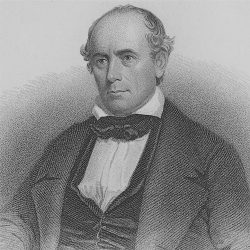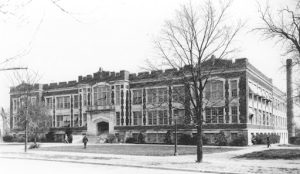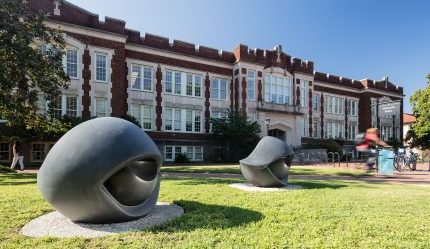About Us
Department History
The history of the UNC Department of Mathematics coincides with the history of the University. When Carolina’s first student, Hinton James, arrived in Chapel Hill on February 12, 1795, the faculty consisted of a headmaster and a professor of mathematics, “First Presiding Professor The Reverend David Ker,” and “Charles Wilson Harris, Princeton graduate and the University’s first tutor [in] Mathematics.” Wilson’s pay consisted of $100.00 annual salary plus one third of the tuition money, free board at the commons, and use of a room in Old East. The other two thirds of the tuition went to the Reverend Ker.
Joseph P. Caldwell came from a job as tutor at Princeton in 1796 to be a “Presiding Professor” of mathematics. In 1804 he was made the first President of the University. The College of South Carolina tried very hard to hire him away but failed. Besides mathematics, he also taught classics. As President, he “longed for a time when he could complete his work in Geometry,” which he eventually did. In 1812 Caldwell returned to the mathematics chair and was replaced as President by Robert Hett Chapman. Chapman was a “peace Federalist” at a time when a war spirit against England existed in the community. Under fire, including student protests, he resigned in 1816, and Caldwell returned to serve as President from 1816 until his death in 1835.

In 1817 Elisha Mitchell, 1793–1857, came from Yale to take up the chair of mathematics and natural philosophy vacated by Caldwell’s second move to the presidency. At this time there were apparently five faculty members at the University. Mitchell introduced fluxions into the curriculum. In 1825 Mitchell moved to the chair of chemistry, geology, and mineralogy and was replaced by James Phillips in the chair of mathematics. Mitchell was state geologist and served twice as acting president of UNC. He died on the mountain that bears his name while verifying his measurements of its height, and he is buried there.

In 1859 the faculty consisted of nine professors and seven tutors. Just before the Civil War, around 1861, Alexander McIver replaced Charles Phillips, 1822–1889, as chair of mathematics, Phillips moving to Davidson. Charles Phillips returned after the war, when the University reopened in 1875. At that time the trustees set up six “colleges”, or departments: agriculture, engineering and the mechanical arts, natural sciences, literature, mathematics, which Charles Phillips headed, and philosophy. Phillips was also named “Chair of the Faculty”. Charles Phillips and Professor of Mathematics James Phillips, 1792–1867, UNC service 1826–1867, are two of the three persons whose name was given to Phillips Hall when it was erected in 1919. The third was William Battle Phillips, 1857–1918, Professor of Agricultural Sciences, who received the first Ph.D. awarded by UNC in 1883. Archibald Henderson, in his book about the campus, said that James Phillips, “somewhat casual in dress and brusque in speech, was believed by the students to be a reformed pirate; a certain plausibility was lent to this wholly unfounded legend by his skill with the foils and a single stick.”
Major William B. Cain, 1847–1930, arrived during the period 1880–1890 and became one of the original five Kenan Professors appointed in 1918. Cain specialized in the mathematics behind engineering and design. His research, writing, and teaching made possible the construction of numerous structures around the country. His sophomore-level course on analytic geometry was regarded as among the most rigorous in the University.
Archibald Henderson, 1877–1963, UNC A.B. 1898, UNC A.M 1899, received the first Ph.D. in mathematics from UNC in 1902, with advisers W. Cain and W. Toy, the latter a professor of Romance Languages. He also directed the next Ph.D. dissertation, that of G.W. Nicholson, in 1933. Henderson was at UNC, except for research in Europe and Chicago, where he picked up a second Ph.D. in 1915, from 1898 until his retirement in 1948. He was Chair from 1920 to 1948 and Kenan Professor beginning in 1926. Henderson was famous for his research on the theory of relativity and his papers and talks defending and explaining it. In several papers he stressed the geometrical basis of relativity and showed how to substitute insight for cumbersome computations. He was perhaps best known as the official biographer of G.B. Shaw. He established as part of UNC’s Rare Book Collection an important collection of materials related to Shaw and his work.
The 1940s saw the arrival of new people and new mathematics from Europe. Nathan Jacobson, 1910–1999, at UNC 1937–1943, and Witold Hurewicz, 1904–1956, worked at UNC in the 40’s, and Alfred Brauer, 1894–1985, at UNC from 1942 until his retirement in 1966, brought strength in modern algebra and number theory and developed the library to world-class status.
William W. Whyburn, 1901–1972, came from the presidency of Texas Tech University to serve as Kenan Professor of Mathematics 1948–1967 and chair 1948–1956 and 1960–1965. F. Burton Jones was Chair from 1956–1960 while Whyburn served as Vice-President of the University system. Besides publishing many papers on differential equations and a basic paper on the theory of the Lebesgue integral, as Vice President for Graduate Studies and Research Whyburn arranged for the purchase, in 1959, of the first computer for the University, launched UNC’s work in computer science, and participated in the founding of the Research Triangle Institute and served on its board.
In the 1960s, F.B. Jones and others made UNC a center for topology. B.J. Pettis, 1913–1979, at UNC 1957–1979, produced fundamental work in functional analysis, including a general theory of integration named after him that is used in applied areas like control theory as well as in other parts of pure mathematics.
Since about 1970, the department has built up its expertise in many of the most active and exciting areas of modern mathematics. It has acquired especially strong groups and noteworthy researchers in the areas of
- Representation Theory
- Partial Differential Equations
- Geometry and Topology
- Applied Math
- Dynamical Systems
- Mathematical Physics
The Math Department supports the University’s core values encouraging diversity and equal educational and employment opportunities throughout the University community, as articulated in the University’s non-discrimination policy and by the Office of Diversity and Multicultural Affairs.


